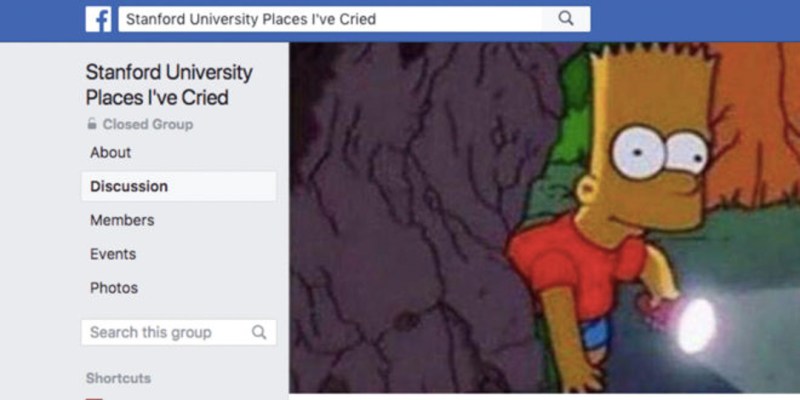In January, “Stanford University Places I’ve Cried” (SUPIC) — a closed Facebook group for students to post about places they have cried on campus — reached 1,000 members. Since then, the group’s membership has nearly doubled, and its administrator, Annie Zheng ’20, has added a Google form to allow people to submit posts anonymously.
“People have changed it from kind of a humorous space to … a confessional space, and it feels a lot like a support group now,” Zheng said.
Posts range from more lighthearted woes to longer stories of mental illness, eating disorders, sexual assault, suicidal ideation and abuse. On many posts, fellow students comment, offering comforting words or for the person who wrote the post to reach out to them directly for support.
Candor through anonymity
Zheng, as well as some group members, have attributed the shift in the group’s tone — and the increased candor in the online forum — to the advent of the option for anonymous posting.
“When its anonymous, people feel freer to share more graphic or shameful details,” Zheng said.
Gabriella Guerra ’19, a member of the group who has posted in it, agreed that anonymity has opened up the group.
“The content of the posts has gotten drastically darker over the last few months,” she said. “When you’re in a state of distress, you’re a lot more likely to entertain these thoughts that you wouldn’t entertain otherwise, but you aren’t necessarily going to post them online when it’s connected to your name, and you know that that has repercussions after that state of distress is over.”
Leela Srinivasan ’18, another member of the group, thinks the anonymous feature has been a positive addition.
“The anonymity of SUPIC has been cathartic for me to vent and see who can relate outside of my usual social circles,” she wrote in a statement to The Daily. “I think it adds a lot of authenticity.”
However, for some, particularly graphic posts can be a source of additional stress.
“[I’m] wondering if this page is still helpful for me to peruse or if it is bringing back too much trauma,” Guerra posted on the page in early March.
Since then, Zheng has added trigger and content warnings on certain posts, as per the requests of some of the group’s members.
“At one point I thought it would be important to add content warnings and trigger warnings to posts,” said Jennie Py ’19, a member of the group. “Since then, the reach out form has been edited to also ask people to put in their own content and trigger warnings, and I think that’s been really great, because it means that I can choose if I want to read a post that has a trigger warning for something I know will be triggering to me.”
The moderation question
However, Guerra feels the trigger warnings are sometimes not enough.
“The trigger warnings have solved some issues but not changed others because it hasn’t changed the mechanism of the posting,” Guerra said, specifically speaking to her concern about suicidal ideation. “Posting online makes the option of suicide more real, and it’s being taken seriously, and suddenly it reaches a new level of reality that it wasn’t at before. I’m worried the format of posting encourages people to entertain these thoughts.”
Guerra, along with some other members of the group who reached out to Zheng anonymously, are instead recommending more direct moderation of the posts in the group.
“I’m wondering if allowing people to post in an anonymous setting about their suicidal ideation is putting more people at risk that are a part of this page,” Guerra said, citing the phenomenon that when people see suicidal thoughts or accounts of successful suicides, they are at a higher risk for suicide attempts. “I’m wondering if it’s better to either limit the number of posts about suicidal ideation or at the very least post the less graphic ones and leave other ones out.”
When asked what her thoughts were on moderating posts, Zheng responded she was not yet sure what to do.
“I have to do a lot of thinking,” Zheng said. “I have to think about what kind of support should it be offering and what the definition of support is.”
Zheng raised concerns that she does not feel she should have the authority to censor posts.
“The problem that I have with moderating is that … it’s up to me to filter out people’s sadnesses and be like, ‘This is not worthy of posting,’” she said. “I think there’s a reason why people consciously open the page, click on the Google form, type out this whole thing with a lot of care and press submit — because they want to get their story out there.”
Py feels that posts should not be moderated.
“I think that this is pretty much the only way for us to hear about how Stanford students are feeling and is also a really great way to connect people with other people who’ve been through similar things,” she said.
Srinivasan agreed.
“It seems that people primarily use the page to vent their own issues, so I think that should be honored, and we should trust the submitters to be diplomatic,” she wrote. “Adding moderation seems like an extra level of being watched or monitored.”
In the end, Zheng feels she has to consider how to shape the page for the Stanford community.
“I try to very much follow exactly what the community wants because it is a space for the community,” she said.
Contact Julia Ingram at jmingram ‘at’ stanford.edu.
